When Sarah transformed her studio apartment with strategically placed pothos and snake plants, her 500-square-foot space suddenly felt like an elegant botanical retreat. You’ll discover how to recreate this effect by positioning plants at varying heights, selecting the right containers, and maximizing natural light patterns in your home. These professional decorating techniques can help you turn any room into a sophisticated green sanctuary, whether you’re working with a cozy corner or an entire open floor plan.
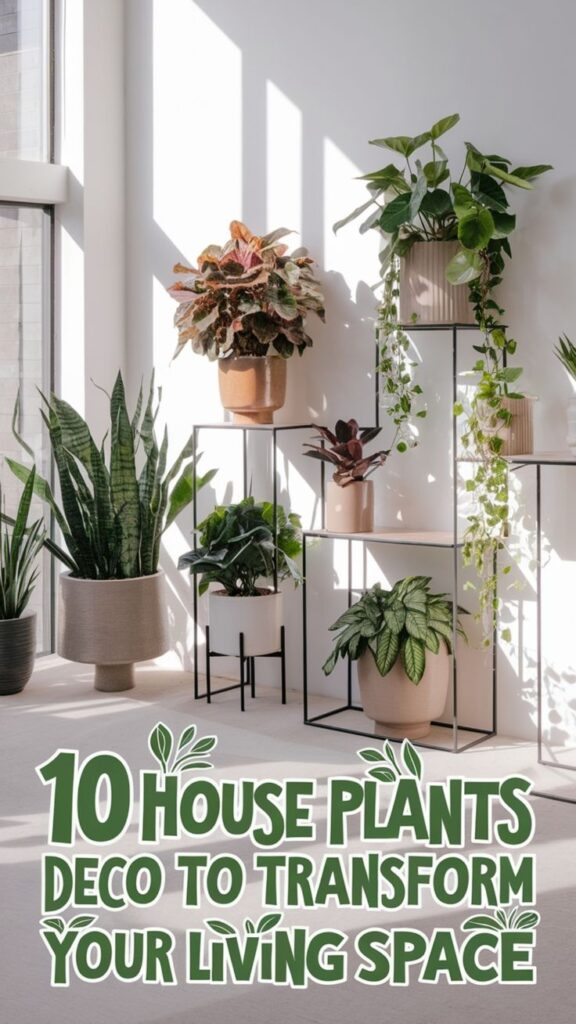
Contents
- 1 Create Plant Clusters at Different Heights
- 2 Style Your Window Ledges With Trailing Plants
- 3 Mix Plant Sizes and Textures for Visual Impact
- 4 Transform Empty Corners With Statement Plants
- 5 Design a Living Wall Display
- 6 Incorporate Plants Into Shelving Units
- 7 Select Creative Plant Containers and Stands
- 8 Arrange Plants Around Seating Areas
- 9 Use Plants as Natural Room Dividers
- 10 Balance Plant Placement With Room Lighting
Create Plant Clusters at Different Heights
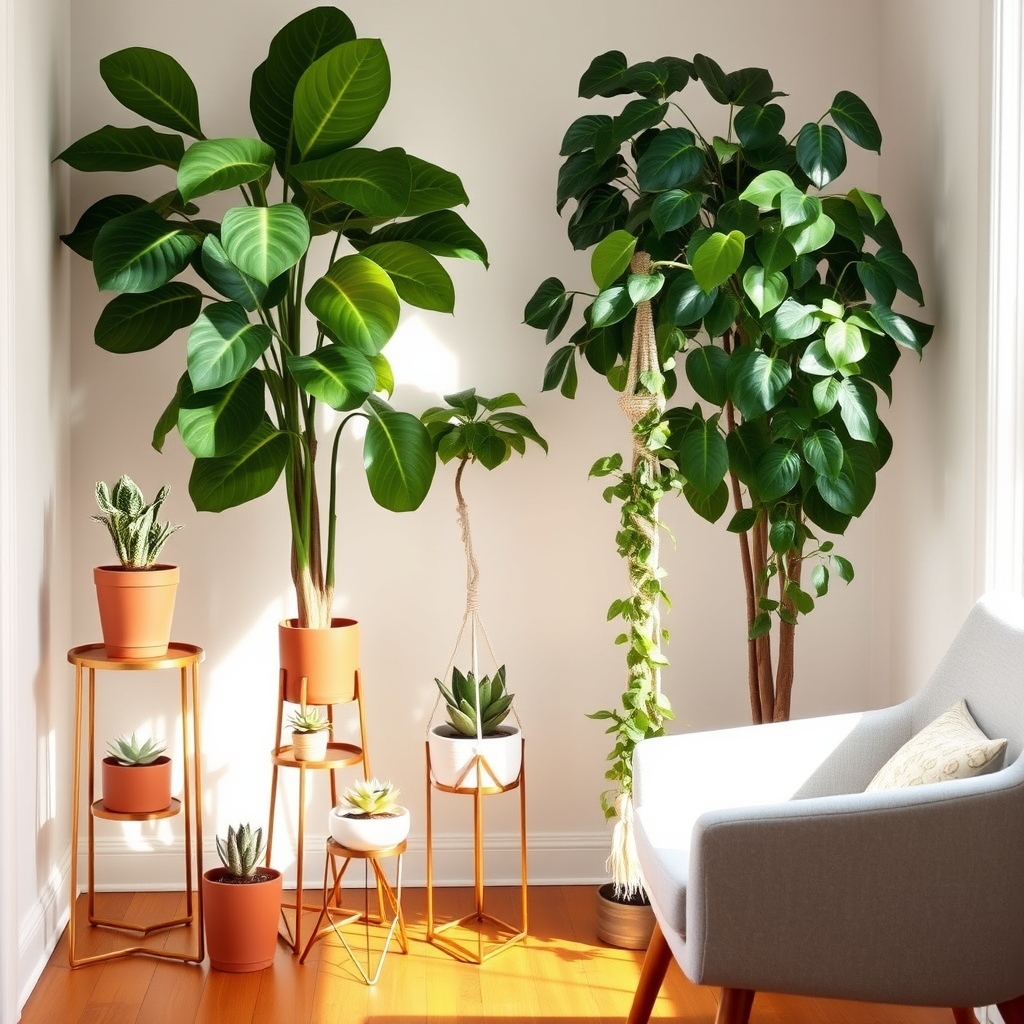
Creating plant clusters at different heights adds visual drama and depth to any room through strategic layering of houseplants. This design approach involves grouping plants of varying sizes, using stands, shelves, hanging planters, and naturally tall specimens to establish multiple vertical levels.
Short trailing plants can cascade from elevated positions while taller specimens like fiddle leaf figs or palm varieties serve as anchoring focal points. The arrangement creates a dynamic, forest-like aesthetic that draws the eye upward and makes efficient use of both floor and vertical space.
Maintaining multi-level plant clusters requires regular rotation of plants to ensure even light exposure, especially for specimens placed in lower positions. Check water needs individually, as elevated plants typically dry out faster than those at ground level.
When dusting leaves, work from top to bottom to avoid dirtying freshly cleaned lower plants. Periodically reassess the arrangement as plants grow, adjusting heights and positions to maintain visual balance and prevent overcrowding that could lead to poor air circulation.
Style Your Window Ledges With Trailing Plants
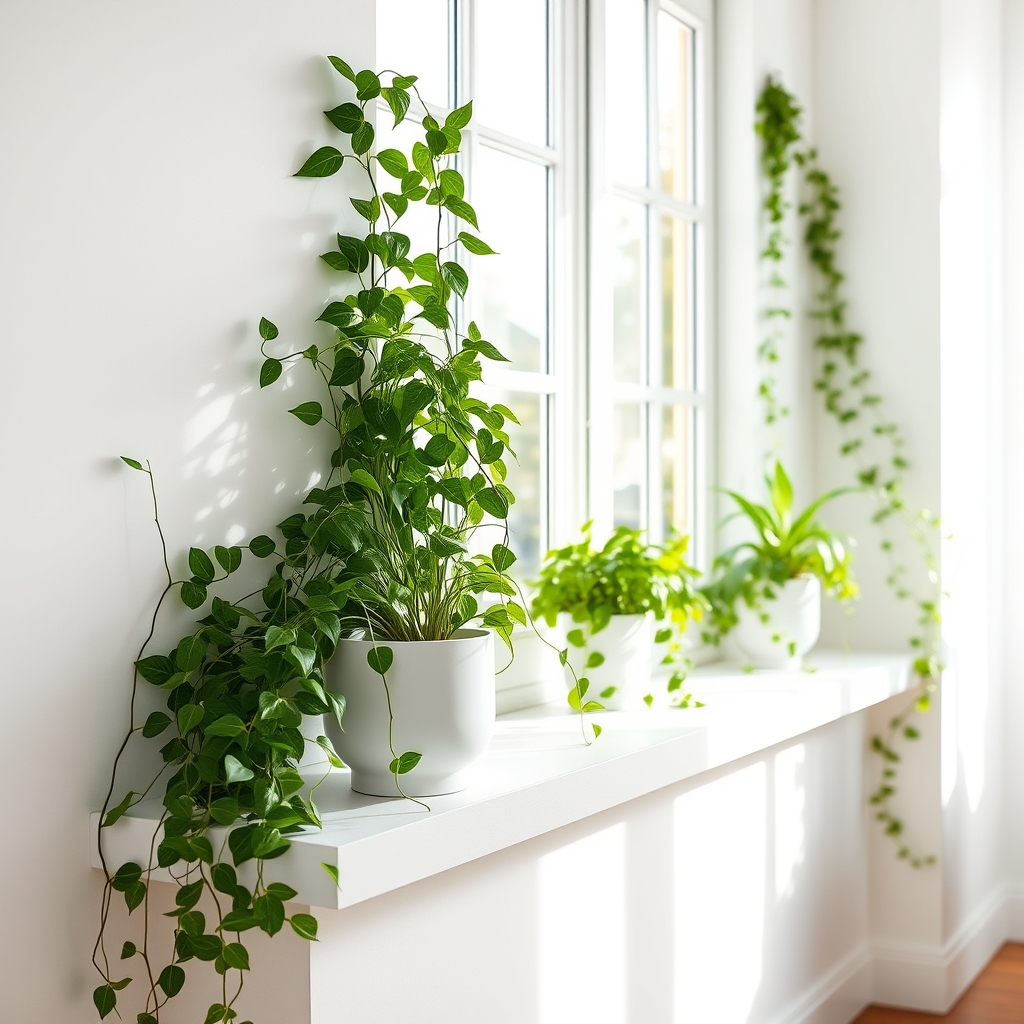
Trailing plants create an enchanting cascade of foliage when styled along window ledges, transforming ordinary windowsills into living curtains of greenery. Popular choices like Pothos, String of Pearls, and English Ivy naturally spill over edges, creating depth and visual interest while maximizing vertical space.
The dangling vines not only soften architectural lines but also frame views and filter natural light, adding movement and organic beauty to any room’s design.
To maintain healthy trailing plants on window ledges, rotate pots quarterly to ensure even growth, as vines naturally grow toward light sources. Trim leggy or sparse vines back to their base to encourage fuller, bushier growth, and use clear adhesive hooks on window frames to guide and support longer vines.
During winter, move plants slightly away from cold windowpanes to protect them from temperature fluctuations, and maintain consistent moisture levels by checking soil weekly, as heating vents near windows can quickly dry out potting medium.
Mix Plant Sizes and Textures for Visual Impact
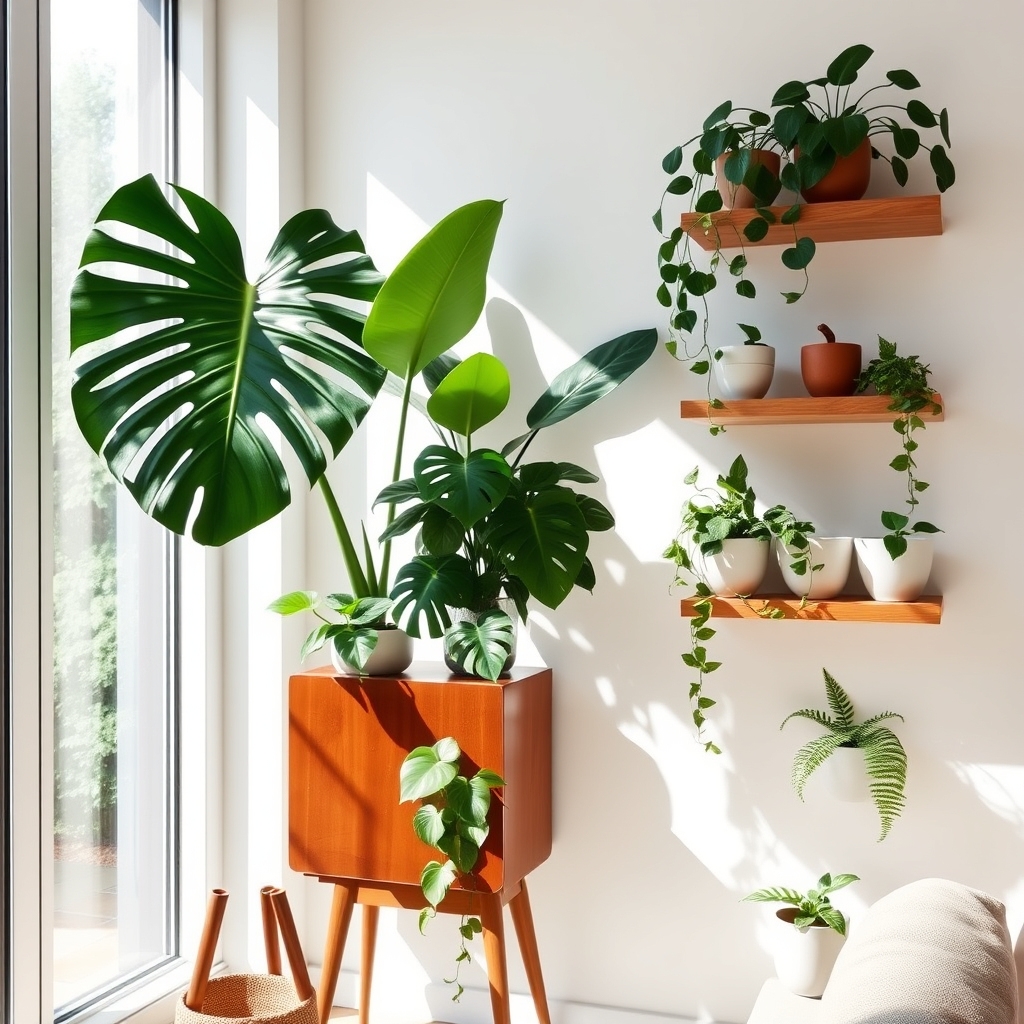
Combining plants of varying heights, shapes, and leaf textures creates dynamic visual interest in any indoor space. Large statement plants like Monstera or Bird of Paradise can serve as focal points, while medium-sized plants like Peace Lilies fill the middle ground, and trailing varieties like Pothos cascade from elevated surfaces.
Positioning plants with different leaf patterns – from broad, glossy leaves to delicate, feathery fronds – adds depth and complexity to the display. This layered approach prevents monotony and draws the eye naturally through the space.
To maintain a mixed plant display effectively, group plants with similar care requirements together, making watering and maintenance more efficient.
Rotate plants periodically to ensure even growth and prevent them from becoming leggy as they reach for light. When adding new plants to the arrangement, quarantine them briefly to prevent potential pest spread, and regularly assess the spacing between plants to prevent overcrowding as they grow.
Adjust plant positions seasonally to accommodate changing light conditions and growth patterns.
Transform Empty Corners With Statement Plants
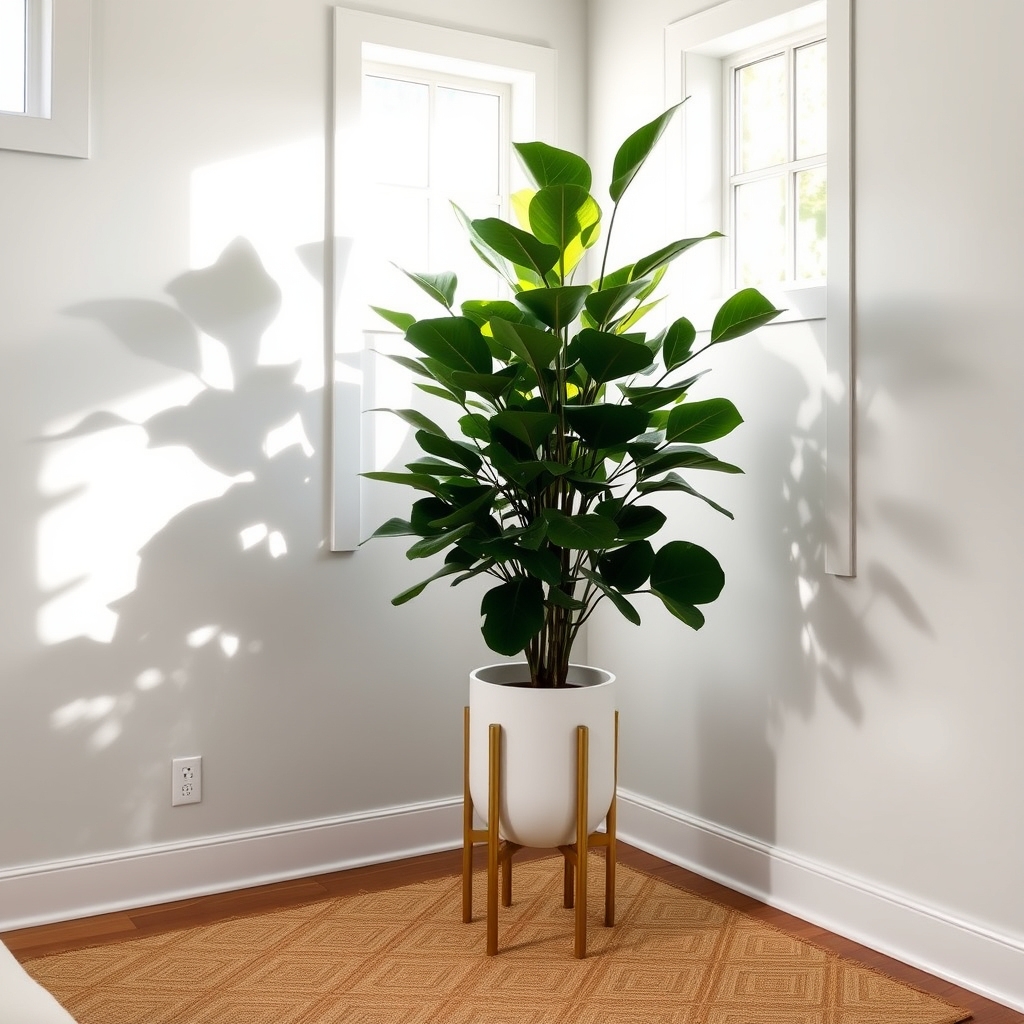
Empty corners can become striking focal points by strategically placing statement plants like Fiddle Leaf Fig, Bird of Paradise, or Monstera Deliciosa.
These tall, architectural plants naturally draw the eye upward and add vertical interest to otherwise unused spaces. The key is selecting a plant that reaches at least 4-5 feet in height and pairing it with an elevated planter or plant stand to create visual impact.
Combining different leaf textures and shapes while maintaining a cohesive look through matching containers enhances the corner’s overall design appeal.
Regular maintenance of corner statement plants involves rotating them quarterly to ensure even growth, as corners typically receive less light from multiple angles.
Check soil moisture weekly, as corner locations may experience different temperature and humidity levels than the rest of the room.
Dust large leaves monthly using a damp cloth to maximize light absorption, and trim any damaged foliage promptly to maintain the plant’s architectural appearance.
Consider installing a grow light if the corner receives less than 6 hours of indirect sunlight daily.
Design a Living Wall Display
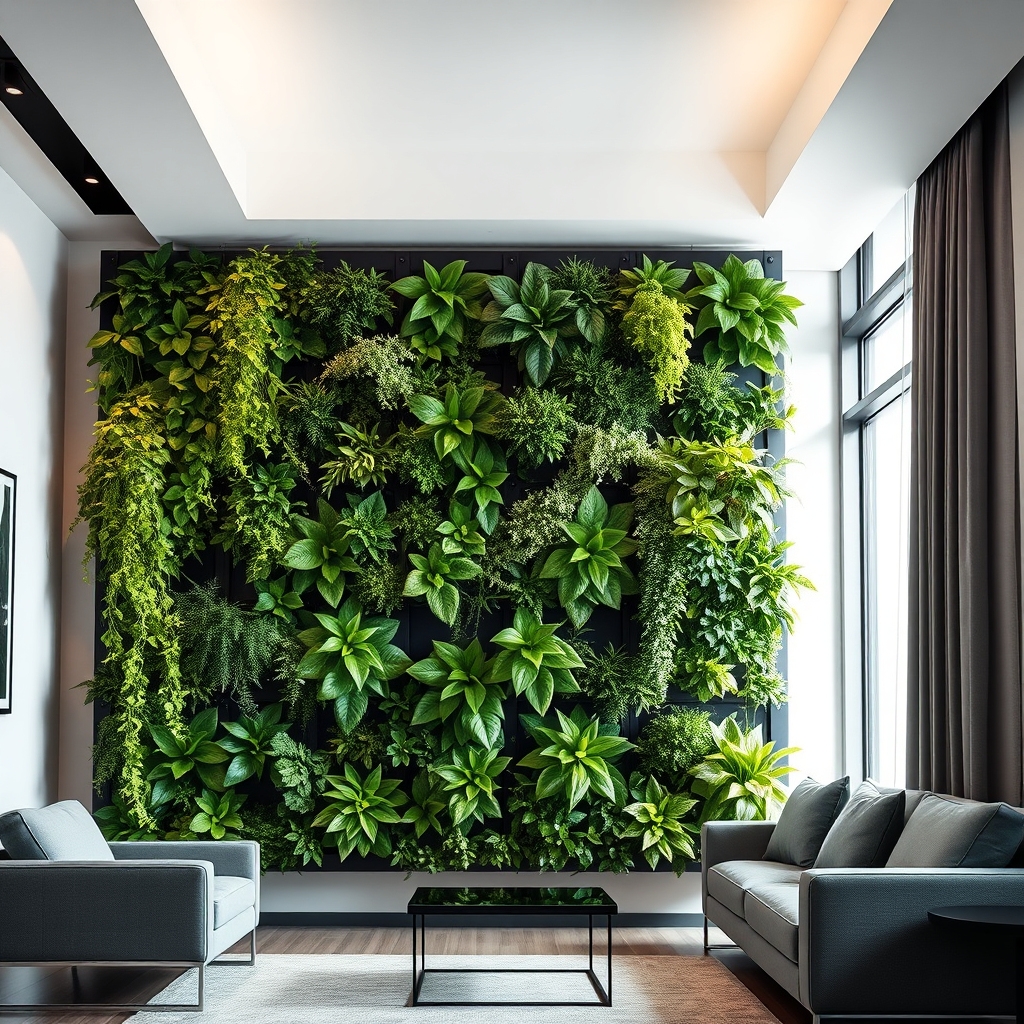
Living wall displays transform vertical spaces into lush, green tapestries by arranging multiple plants in a structured grid or organic pattern on a wall-mounted system.
These displays typically feature a combination of trailing, upright, and cascading plants installed in modular panels or pocket planters, creating a dynamic living artwork. The setup can incorporate various textures and colors through different plant species like pothos, ferns, philodendrons, and succulents, while specialized mounting frameworks provide both structural support and irrigation channels.
Regular maintenance involves checking the irrigation system weekly, trimming overgrown plants monthly, and monitoring for signs of pest infestation or disease.
The growing medium should be tested every three months for proper pH levels and nutrient content, with fertilizer applied as needed during the growing season. Dead or struggling plants must be promptly replaced to maintain the display’s aesthetic appeal, while dust should be gently wiped from leaves every few weeks to ensure optimal photosynthesis.
During winter months, supplemental grow lights may be necessary if natural light is insufficient.
Incorporate Plants Into Shelving Units
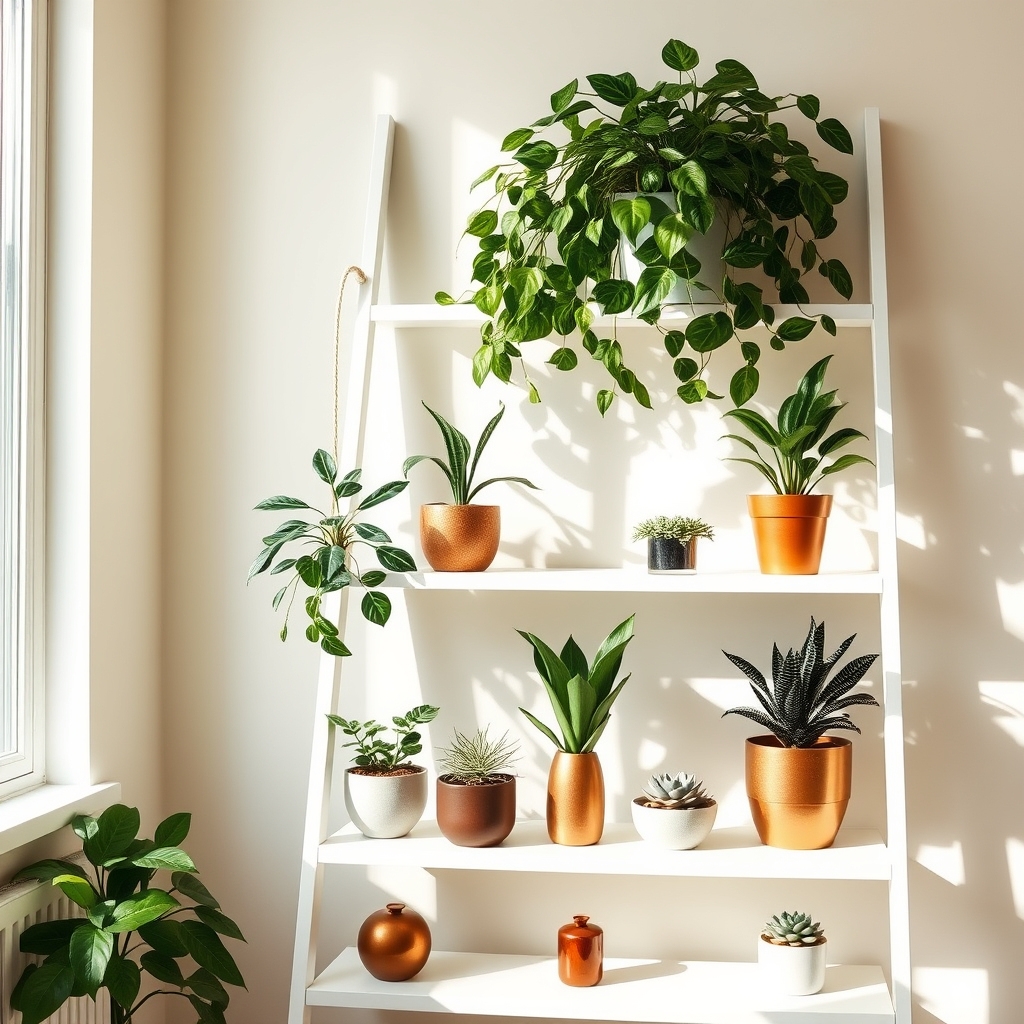
Styling shelving units with plants creates dynamic visual interest through varying heights, textures, and depths. Plants can be arranged on different shelf levels, with trailing varieties like pothos or string of pearls cascading down from upper shelves while compact specimens like succulents occupy lower spaces.
Mixing plant sizes and incorporating decorative pots enhances the aesthetic impact, while leaving negative space between plants prevents the arrangement from appearing cluttered. This versatile approach works particularly well with ladder shelves, floating shelves, or traditional bookcases, allowing plants to share space with books and decorative objects.
Maintaining plants on shelves requires careful attention to light exposure and watering schedules. Position sun-loving plants on upper shelves closer to windows, while shade-tolerant varieties can thrive on lower levels.
Use saucers or decorative trays under pots to protect shelving from water damage, and consider using self-watering planters for hard-to-reach specimens. Regular dusting of both plants and shelves prevents buildup that can affect plant health, while quarterly rotation of plants ensures even growth and prevents permanent leaning toward light sources.
Select Creative Plant Containers and Stands
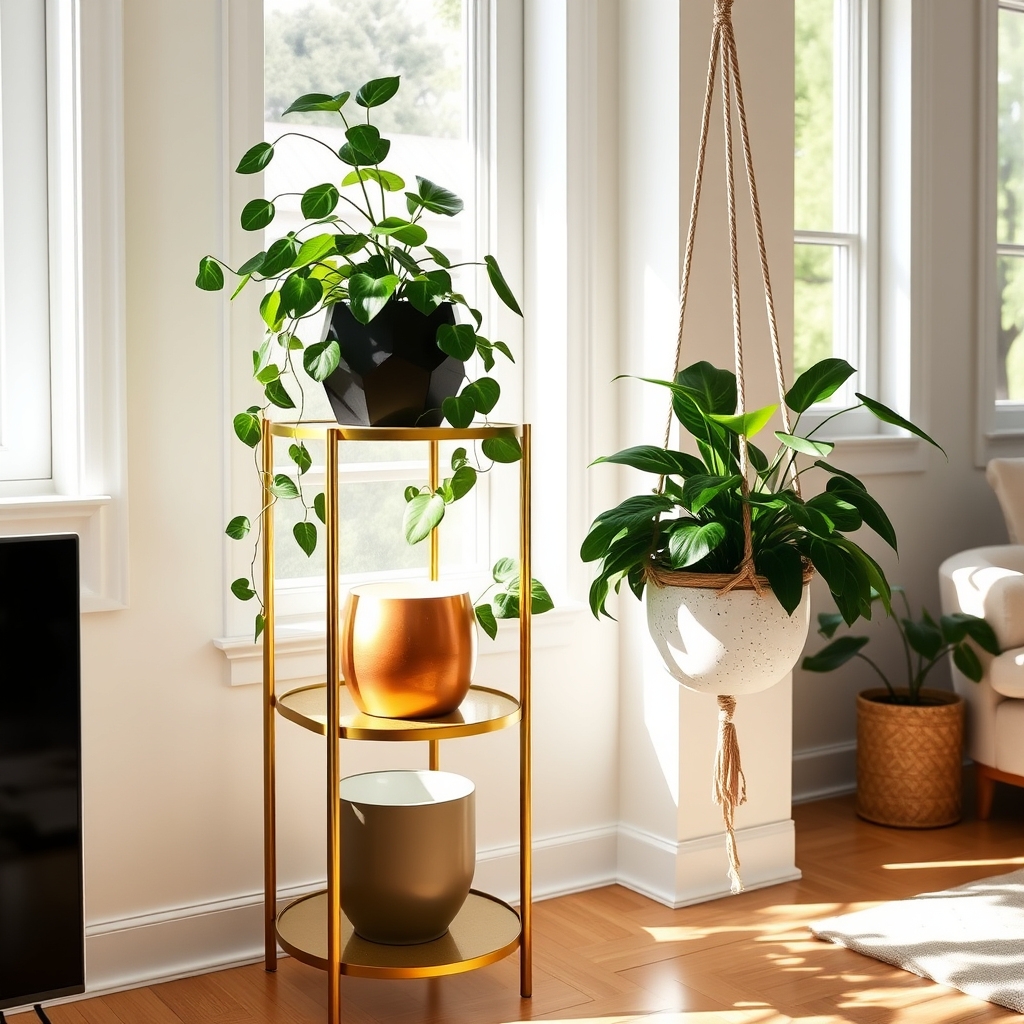
Creative plant containers and stands transform ordinary houseplants into striking design elements through unconventional vessels and elevated displays. These can include repurposed vintage items like teapots, old boots, or wooden crates, as well as modern geometric planters, hanging macramé holders, and sculptural metal stands.
Multi-tiered plant stands allow for vertical gardening in small spaces, while wall-mounted containers create living wall art. The key design elements incorporate varying heights, textures, and materials that complement both the plants and existing room décor.
To maintain creative containers and stands, ensure all vessels have proper drainage holes or use a cache pot system to prevent water damage to furniture and floors.
Clean stands regularly to prevent dust buildup and rust formation, particularly on metal components. For repurposed containers, apply a waterproof sealant to protect non-traditional materials from moisture damage.
Rotate plants periodically on multi-tiered stands to ensure even light exposure, and check wall-mounted containers regularly to verify secure attachment and prevent water damage to walls.
Arrange Plants Around Seating Areas
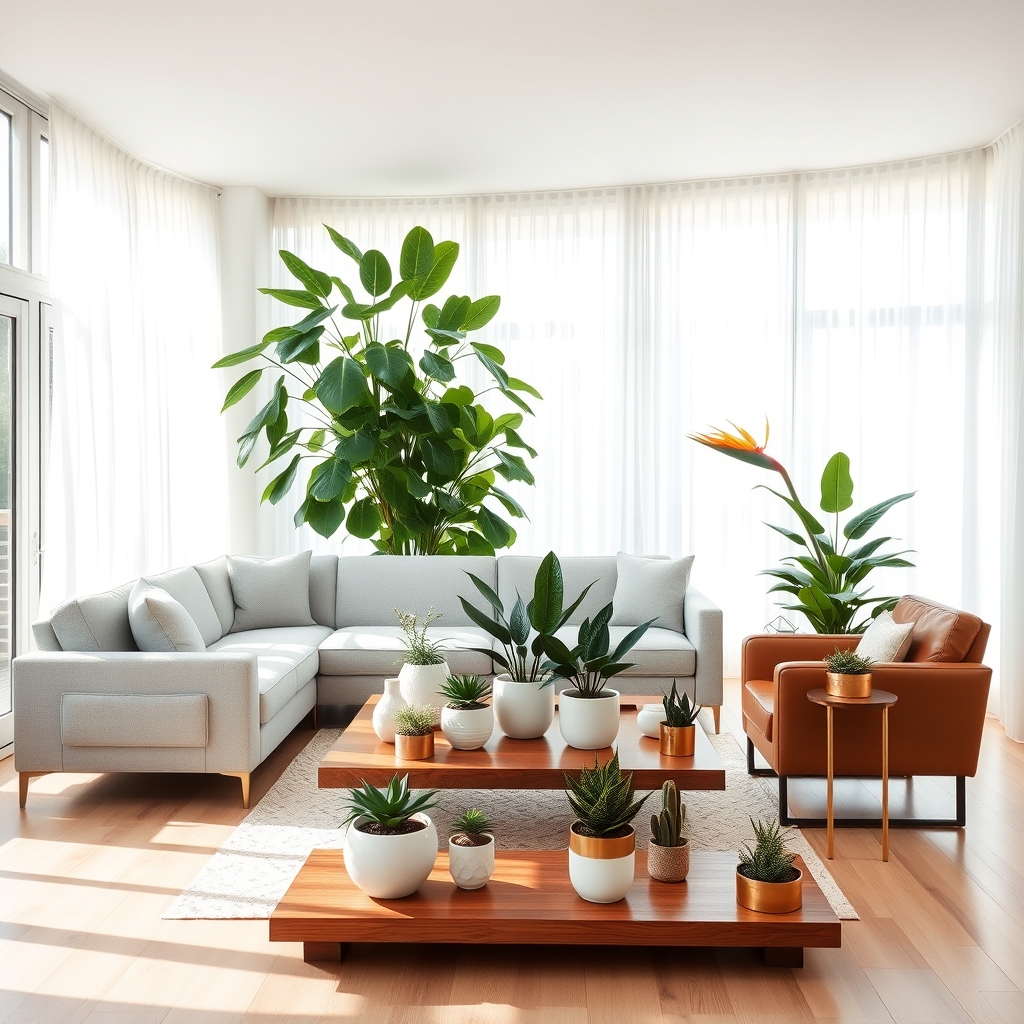
Strategically placing plants around seating areas creates an intimate, nature-inspired atmosphere while maximizing visual impact in conversation spaces. Tall floor plants like fiddle leaf figs or bird of paradise can serve as natural room dividers when positioned behind sofas, while smaller potted plants on side tables and coffee tables add layers of green at different heights.
Clustering plants of varying sizes near reading nooks or gathering spaces helps frame the area and draws the eye inward, making the space feel more welcoming and purposeful.
Regular rotation of plants around seating areas helps ensure even growth, as some spots may receive more light than others. When arranging plants near seating, consider leaving adequate space for air circulation and cleaning, typically 6-12 inches between plants and furniture.
Check regularly for water drips or soil spills on upholstery, and place protective saucers or decorative trays under pots to prevent damage to furniture or flooring. During social gatherings, temporarily relocate delicate or trailing plants to prevent accidental damage from guests moving around seating areas.
Use Plants as Natural Room Dividers
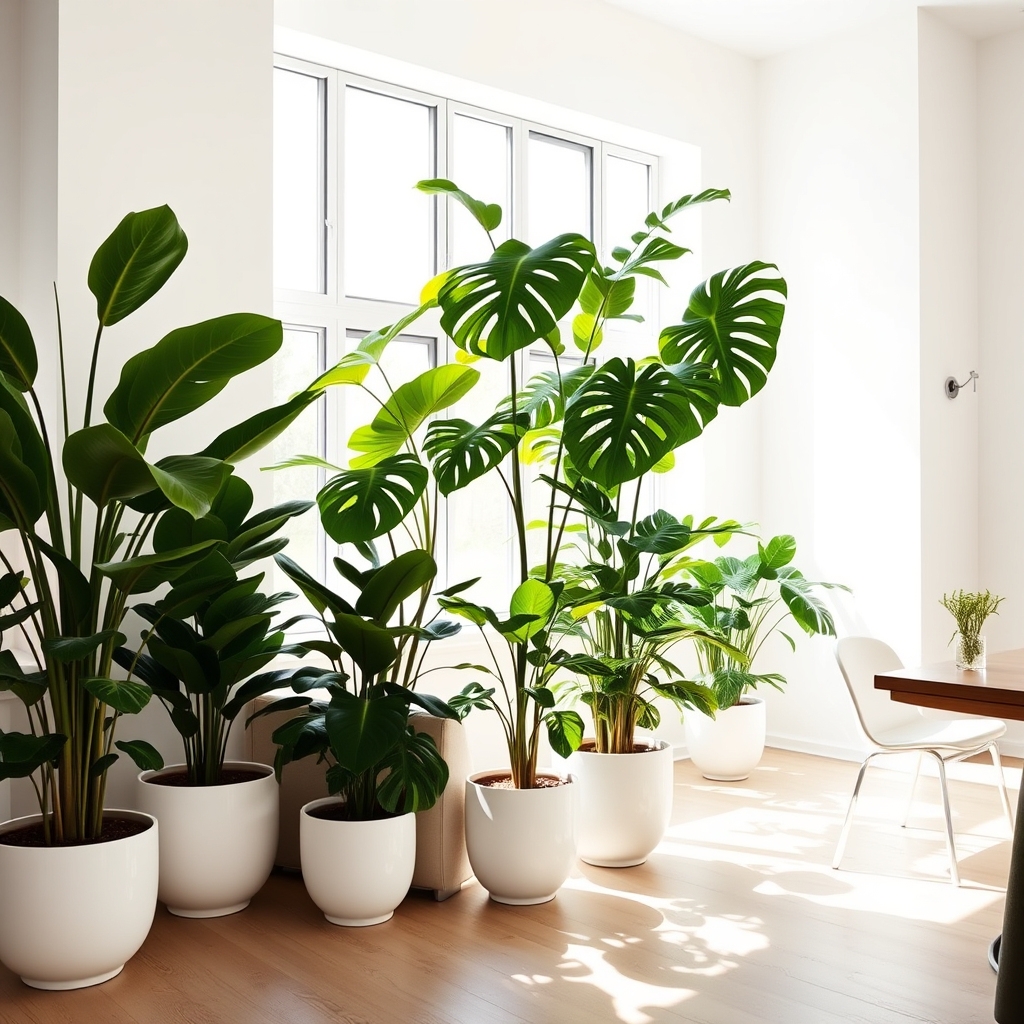
Using plants as natural room dividers creates an organic and stylish way to separate spaces without installing permanent walls or bulky furniture. Tall plants like bamboo, fiddle leaf figs, or monstera deliciosa can be strategically placed in a row or clustered arrangement to establish distinct zones within an open floor plan.
These living barriers add depth, texture, and visual interest while maintaining airflow and natural light throughout the space. The height and density of the plants can be varied to achieve different levels of privacy and spatial definition.
Regular maintenance of plant dividers requires consistent attention to prevent the arrangement from becoming unruly or sparse. Rotate the plants quarterly to ensure even growth and prevent them from leaning toward light sources.
Prune regularly to maintain desired shapes and heights, and check for pests that can easily spread between closely positioned plants. When watering, ensure adequate drainage to prevent root rot, as plants in close proximity can create humid microclimates.
Consider placing plants in lightweight containers with casters for easy mobility during cleaning or rearrangement.
Balance Plant Placement With Room Lighting

Proper balance between plant placement and room lighting creates visual harmony while ensuring optimal growing conditions for houseplants.
Strategic positioning involves placing light-loving plants near windows, shade-tolerant varieties in darker corners, and creating multi-level displays that maximize available natural light. This arrangement not only supports plant health but also adds depth to room design through varying heights and textures, with taller plants acting as natural focal points and smaller ones filling intermediate spaces.
To maintain ideal light conditions, rotate plants quarterly to prevent one-sided growth and adjust positions seasonally as sun angles change.
Monitor leaf response – yellowing often indicates too much light, while sparse growth suggests insufficient light. Install sheer curtains to diffuse harsh direct sunlight when needed, and consider supplementing natural light with grow lights during darker months.
Clean windows regularly to maximize light transmission, and group plants with similar light requirements together for easier maintenance.
